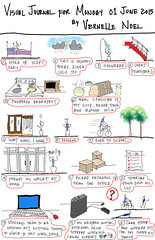This is a drawing I did in summer 2003 of the Old Executive Office Building, now renamed the Eisenhower Executive Office Building in Washington, DC. This was my first summer in DC, and I took all the time I could to explore and sketch this beautiful city. The Eisenhower Executive Office Building is located next to the West Wing, and houses a majority of offices for White House staff. Originally built for the State, War and Navy Departments between 1871 and 1888, the EEOB is an impressive building that commands a unique position in both our national history and architectural heritage. Designed by Supervising Architect of the Treasury Alfred Mullett, the granite, slate and cast iron exterior makes the EEOB one of America’s best examples of the French Second Empire style of architecture. It took 17 years for Mullett’s masterpiece to finally be completed.
Facts about the Old Executive Office Building:
Architectural Style: French Second Empire
Construction Dates: 1871 – 1888 (17 years total)
Supervising Architects: Alfred Mullett (1869-1874), William Potter (1875-1875), Orville Babcock (1875-1877), Thomas Lincoln Casey (1877-1888)
Chief Designer: Richard Ezdorf
Total Cost: $10,038,482.42
Total Building Area: 662,598 GSF (15.21 acres or 11 1/2 football fields)
Number of Levels: Basement, Ground, Floors 1 through 5
Original Number of Rooms: 553
Exterior Columns: 900
Original Interior Doors: 1,314
Original Exterior Windows: 1,572
Bronze Stair Balusters: 4,004
Number of Steps: 1,784 (76 less than the Empire State Building with 1,860 steps)
Number of Stairs: 65
Total Corridor Length: 9,160′-1″ or 1.73 miles (2.793 kilometers)
Number of Original Fireplaces: 151 (83 remain)
Reference: http://www.whitehouse.gov/about/eeob

About ALFRED B. MULLETT (1866–1874)
Alfred Bult Mullett is the best known of the fifteen men who served as supervising architect of the Treasury Department. Mullett was born in 1834 in Taunton, Somerset County, England, the eldest son in a family engaged in farming and the running of a drygoods store in town. Drawn by the attractive prospects of the United States, the Mullett family left their native country in 1844 and settled in Glendale, a town to the north of Cincinnati. There they farmed while Mullett attended Farmers’ College, an institution founded in 1833 as Cary’s Academy and later incorporated into the University of Cincinnati. Farmers’ College was described as “an institution of learning especially suited to the wants of the agricultural and business community. ”
In 1854, in his sophomore year, Mullett left the school at his own request, having studied mathematics and mechanical drawing. Part of his reputation can be ascribed to the survival and growing appreciation of his sprawling State, War, and Navy Building located on the block just west of the White House. He also personified the supervising architect’s near total control over public building design in an era when the architectural profession was becoming defined to the public. Thus, his was a monopoly that drew increasing levels of opposition from the community of private architects, now banded together into the American Institute of Architects (AIA). He was like an entrepreneur—although in this case a bureaucratic operator—in that he fought his enemies bitterly to hold onto his power. Long after Mullett left the Supervising Architect’s Office, his name continued to be cited by private architects as representing all that was wrong with federal government architecture.
The rise of Mullett to the position of supervising architect coincided with a period of prosperity and political stability. The buildings designed for federal government purposes were on a scale that dwarfed Ammi B. Young’s buildings.
Reference: Architects to the Nation: The Rise and Decline of the Supervising Architect’s Office by Antoinette J. Lee
Sketch something today!

This work by Vernelle Noel is licensed under a Creative Commons Attribution-NonCommercial-NoDerivs 3.0 Unported License.



















